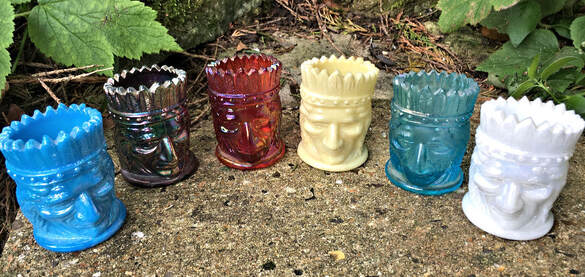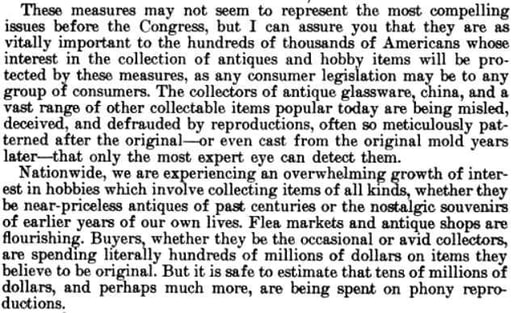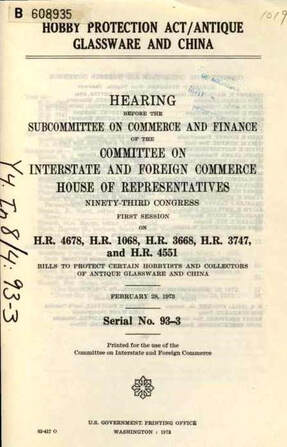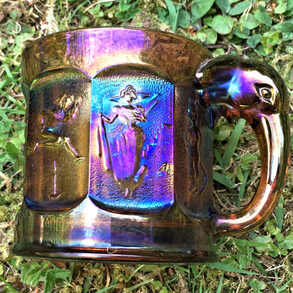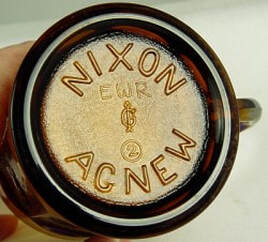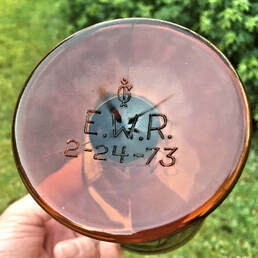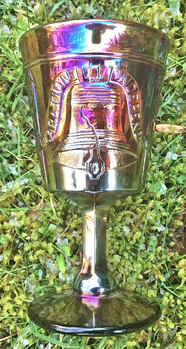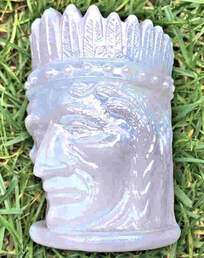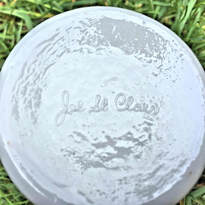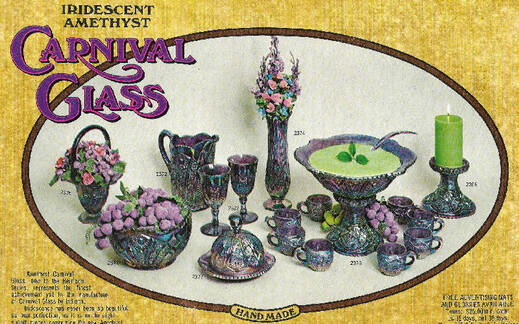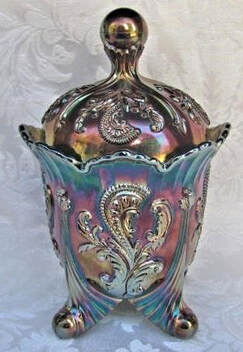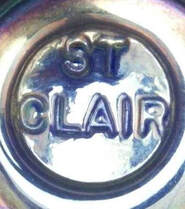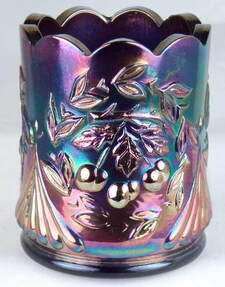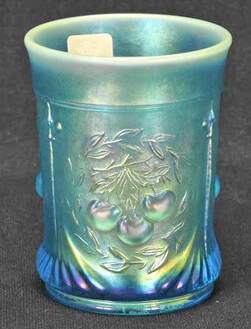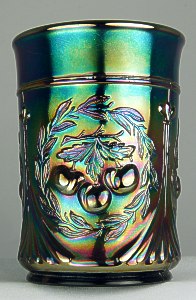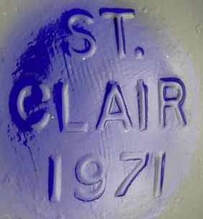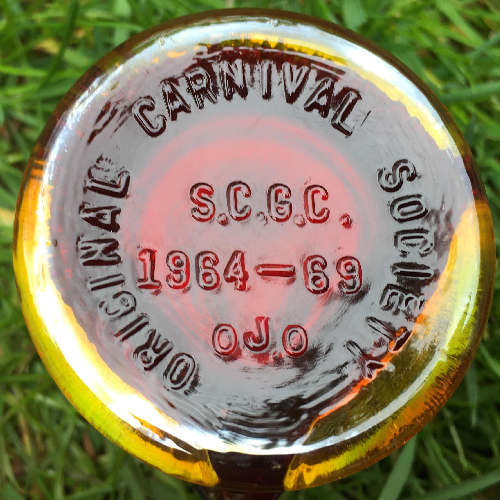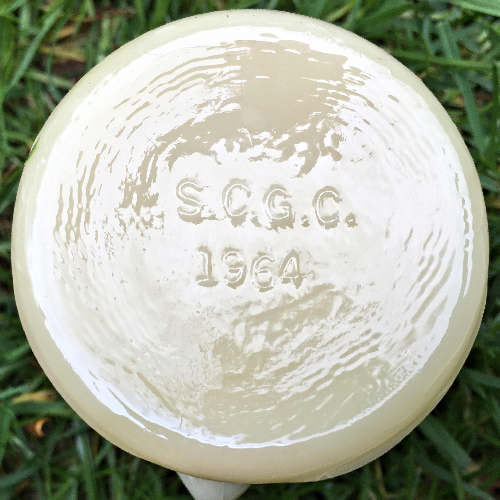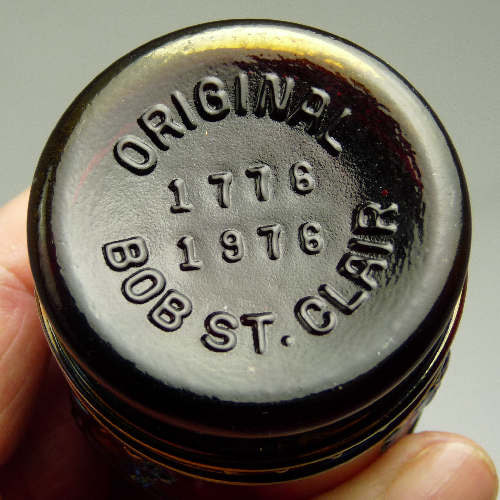The Hobby Lobby!
|
What might have been.
|
Updated from our original article in April 2015.
|
This is the key effect of The Hobby Protection Act, which was signed into United States law in 1973.
The manufacture in the United States, or the importation into the United States, for introduction into or distribution in commerce,
or the sale in commerce of any imitation item [as specified in the Act] which is not plainly and permanently marked "copy", is unlawful
and is an unfair or deceptive act or practice in commerce under the Federal Trade Commission Act.
What was covered by the Act? It was designed to protect collectors against deceptive reproductions and imitations of collectible items. When it became law, the scope of the Act was to cover reproductions and imitations of coins, other numismatic items, and political items (such as political buttons, posters, literature, stickers, and advertisements).
So ... what's the connection with Carnival Glass and what's the relevance of the picture below?
|
Our story began when we saw an article in a 1973 Washington newspaper, describing the lead-up to the Hobby Bill before it became law. What really caught our attention was this (the words in bold are our emphasis): "Along with worldly woes and money matters, there's talk on Capitol Hill about a White Carnival Glass Indian Chief toothpick holder and a Mt. Washington Peachblow vinegar cruet." What!! Carnival Glass was being discussed at the centre of government in the USA? The full newspaper article was entitled "Washington's Hobby Lobby Bill Is Aimed At Protecting Against Purchase of Copies". To cut a long story short, it was about the intended scope of the proposed Hobby Protection Act (1973). |
In the original discussions, there was lobby pressure for the Act to include protection against fakes and reproductions in hobbies such as glass collecting (and specifically Carnival Glass collecting). However, it was not to be, as the feeling was that existing laws and regulations provided sufficient protection in these areas.
In the original discussions, there was lobby pressure for the Act to include protection against fakes and reproductions in hobbies such as glass collecting (and specifically Carnival Glass collecting). However, it was not to be, as the feeling was that existing laws and regulations provided sufficient protection in these areas.
|
We are left wondering how different it might have been for collectors if the Act had also covered Carnival Glass. Nevertheless, we were intrigued to find out about the lobbying and the lobbyists, and on further investigation, we unearthed the text of the full 1973 Hearing (see cover, right). It proved to be absolutely fascinating! These three extracts from information given to the subcommittee show just how high feelings were running about reproductions and deceptions, even back then ... and they still apply now! Above: extract of a statement from Mr. Rooney,
a representative in Congress for Pennsylvania. |
The Hobby Protection Act
|
What was going on in Carnival Glass collecting at that time?
To explain this, we need to delve into another statement given to the subcommittee - one that really caught our attention - from E. Ward Russell. His statement provided a fascinating and contemporaneous insight into the world of Carnival Glass collecting in the late 1960s - early 1970s.
To explain this, we need to delve into another statement given to the subcommittee - one that really caught our attention - from E. Ward Russell. His statement provided a fascinating and contemporaneous insight into the world of Carnival Glass collecting in the late 1960s - early 1970s.
|
The general situation around that time was that Classic Carnival collecting had become well organised (from the early 1950s, thanks to the considerable efforts of early Carnival Glass Pioneers), and glassmakers, seeing the growth in its popularity, were beginning to embark upon the great Carnival Glass Revival, reworking old moulds, and introducing new patterns, new shapes and new colours. It was also the time when some Classic Carnival collectors - and even clubs - showed a reluctance to accept the new Carnival that was being made by an increasing number of glass factories, some of them from the Classic era (such as Imperial, Fenton and Westmoreland), as well as Carnival "newcomers" (including St. Clair, Indiana Glass, L. E. Smith and Mosser). Interestingly, despite some resistance to the new Carnival, there was a willingness to accept it for, for example, Carnival club souvenirs. It was also a time when collectors were becoming more concerned about reproductions and fakes, and their impact on Carnival collecting. |
Storybook (aka Nursery Rhyme) mug was originally a Heisey mould *. It was later made by Imperial in various colours. An elephant head/trunk forms the handle, and it has 8 panels featuring nursery rhyme characters. This one was a limited edition made in amber in 1972. As shown on the base, it was made as a Nixon / Agnew political souvenir
and has the "IG" mark as well as "EWR" for E. Ward Russell who commissioned it. |
E. Ward Russell himself was well known in Carnival Glass (as well as in Washington political circles, having worked in the White House in the 1950s). At the Hearing he was described as the “Editor and Publisher, National Carnival Glass News”. He further informed the subcommittee that he was “president emeritus of the American Carnival Glass Association (ACGA), having served from 1966 to 1972 and I devote almost all my entire time researching Carnival Glass.” He had been one of the founders of the Nation's Capitol Carnival Glass Club in 1964 and it was this club that transitioned into ACGA. He also commissioned Carnival Glass items to be made (by several glass companies) for club souvenirs and for his own business, ensuring that they were made with his initials, EWR, permanently moulded into the piece - see the Storybook mug pictured above.
* The Storybook / Nursery Rhyme mug was originally made by Heisey (and marked with their H in a Diamond mark on the base), but not in Carnival Glass. It was designed by Horace King in 1946/47 – initially, the panels were plain, but King then came up with the idea of portraying nursery rhyme characters, and calling it the “Baby Mug” (it was Heisey’s #1591). It was reproduced in more recent times for the Heisey Collectors of America in pink and blue (not iridised) and sold in the National Heisey Glass Museum Gift Shop. Source: Heisey News April 1973, reprinted in April 2006.
|
|
In 1968, when some new iridescent products from the St. Clair Glassworks began to appear on the market, a dealer in Front Royal, Virginia, was sold a "white carnival glass Indian Chieftain toothpick holder" for $50.00. It bore no trademark of any kind, so the dealer had no way of knowing that it was NOT a rare piece of old carnival glass. It was a product that sold for $2.00 whole sale—or about $5.00 retail. A member of our local collectors' club recently bought a covered candy dish which the seller believed was old. It was another St. Clair product (see below). Upon verification by more knowledgeable collectors, the man was able to return the item to the seller for a refund. Here in Virginia (The Thieves Market), a dealer was offering for sale a Feather Scroll [known today as Inverted Fan and Feather] toothpick holder as a carnival glass "rarity" for $125.00. This too, was a St. Clair product. The dealer was so informed by more than one collector from this area. In fact, another dealer just two shops away—in the same building—had the very same toothpick holder in a different color for $8.00. This knowledge did not deter the dealer from maintaining her asking price of $125.00. (She believed that since it had been bought with other pieces of old carnival glass, it HAD to be old.) |
Above: an example of a white (lightly iridised milk glass) Indian Chieftain toothpick (aka Indian Chief, aka Indian Head), made by St Clair. This one is signed "Joe St. Clair" on the base, unlike the one that E. Ward Russell referred to. The moulded signature is not very pronounced, so it is also possible that it had been ground off the one that Ward Russell heard about.
|
In the 1970's, Indiana Glass Company of Dunkirk, Indiana, began producing an iridescent glassware which they market as "Carnival Glass." This is directly capitalizing on a name—a misnomer —given to the iridescent glassware of the early 1900's which was called Taffeta Luster, Golden Iridescent, Rhadium (sic) Ware, Rubigold etc. CARNIVAL GLASS was a nickname that "stuck" as this glass became collectible.
It represents a glassware of a particular era—and to use the name "Carnival Glass" on a modern product with no mark to indicate that it IS a modern product, is misleading.
|
It is no wonder that persons with no scruples will go into a "dime-store" to buy a sample of this glass for $1.47 and take it to a shop or flea market and offer it for sale as "Carnival Glass" at $12.50. Above: E. Ward Russell objected to this use of the term "Carnival Glass" by companies such as Indiana Glass, as he believed strongly that the term should be used only for Classic (old) Carnival.
|
Above: a blue Inverted Fan and Feather covered sugar (called Feather Scroll by E. Ward Russell), made by St. Clair. Courtesy of Burns Auctions.
|
|
If these products were marked with a year of manufacture permanently moulded into the glass, there would be no room for this kind of fraud. Arguments will be put forth that it would be difficult and expensive for manufacturers to mark the glass in this way. If that is the case, why then would the St. Clair Glassworks choose to mark some of their products and NOT others of the exact same mould? For example, the Wreathed Cherry toothpick holder (which is an OLD pattern and was known to have been made in carnival glass originally) can be found with the following impressed in the base: “ST CLAIR 1971”. If it could be done for one item, why not for ALL REPRODUCTIONS? Some manufacturers have voluntarily marked their re-issues of carnival glass with a new trade-mark. (Imperial —IG; Fenton —word Fenton in script; and Smith Glass —"S") This has helped—but it is not the ultimate solution to the reproduction problem because people have mistaken these hallmarks for OLD trademarks. Example! A well-known reference book, "Know Your Antiques" by Ralph and Terry Kovel, states that the IG mark of Imperial Glass Co. was used in the early 1900's. This is an error that has caused many people to make the costly mistake of buying Carnival Glass with the IG (current production) as OLD. (A dealer in |
Here is the St. Clair mark on a Wreathed Cherry toothpick (right). It was not made in this shape in Classic Carnival.
|
Anchorage, Alaska, "Mr. 5% Antiques", bought 20 or 30 pieces of Imperial re-issues believing it was OLD —and he paid well over the fair market value.)
Some time ago, an ad appeared in the Antique Trader offering Carnival Glass "signed Fenton" for sale. No mention was made in the ad that this was NEW carnival glass. When this was brought to the attention of the Trader staff the ad was dropped. If these products were DATED there would be no question about the age of the item, regardless of the hallmark used.
Some time ago, an ad appeared in the Antique Trader offering Carnival Glass "signed Fenton" for sale. No mention was made in the ad that this was NEW carnival glass. When this was brought to the attention of the Trader staff the ad was dropped. If these products were DATED there would be no question about the age of the item, regardless of the hallmark used.
|
During the hearing, various additional comments were made, and we noticed this one in particular, again from E. Ward Russell (right). We are not entirely sure what he was referring to in this extract, but we can think of at least three possibilities where "post-production" processes were used - the Hansen brothers and Terry Crider, Sara Comer, and "Marlin".
In the 1960s, Ronald and Robert Hansen started iridising glass items, some old and some new. They bought (uniridised) glass made by various companies, reheated them and applied a spray of metallic salts to create an iridescent or "Carnival" finish. Due to the reheating, most pieces - but not all - have a pontil mark, and most - but again not all - were signed with an etched signature. Terry Crider also used this process, starting in the mid 1970s, and like the Hansens, most of his pieces were signed. Sara Comer used a cold application of iridescent salts to glass made by various companies, including Heisey and Cambridge. Her work started as early as 1916 and continued into the 1920s. "Marlin" is a term used in the glass community to describe clear/crystal glass that has been given a light amber/marigold iridescent lustre by immersion in cold water mineral springs. An alternative term is "water ambered" glass and it is not as unusual as you might expect! Here are links to further information about Sara Comer and "Marlin" glass: But the hearing was all to no avail. Despite the evidence and the protests, the subsequent legislation did not cover glass. The scope was limited to imitation political and numismatic items only. With hindsight, there would have been some problems over time. New glass, made outside the jurisdiction of the Act, could be mistaken for "old glass" simply because it did not have a maker's mark. It would assume a sort of legitimacy, especially when circulated in the secondary market. |
Above: Wreathed Cherry tumblers. On the left is a Crider one iridised post-production, in blue opal, and on the right an original, Classic Dugan-Diamond in blue. The tumbler was not made in blue opal in Classic Carnival.
|
Fakers would not need to fake a mark - because the absence of a mark would be a test for old glass. Also, a moulded date would have added to glassmakers' costs: moulds were a major part of their cost of production, and moulds were used, and reused, over long periods of years. Having to use a new mould base plate (where the marks are usually found), would have been a logistical problem and a costly exercise.
Ultimately, for Carnival collectors, it is a case of "knowledge is power" - know the makers, their patterns, colours and shapes, which after all, is one of our key aims and objectives here on our website, Carnival Glass Worldwide!
Ultimately, for Carnival collectors, it is a case of "knowledge is power" - know the makers, their patterns, colours and shapes, which after all, is one of our key aims and objectives here on our website, Carnival Glass Worldwide!
Let’s finish where we began, with St. Clair Glassworks. We think that it was rather unfair of E. Ward Russell to appear to single out St. Clair for criticism. Admittedly, not all St. Clair's Carnival was marked, but much of it was.
Here is a selection of St. Clair marks.
Here is a selection of St. Clair marks.
